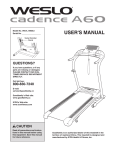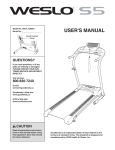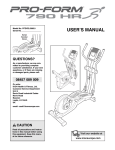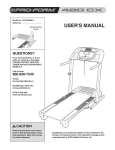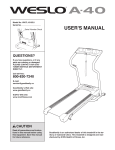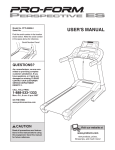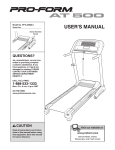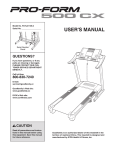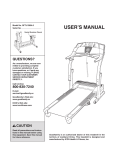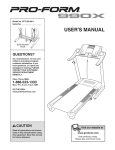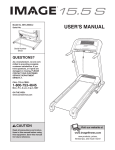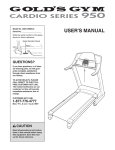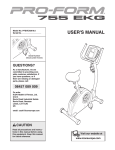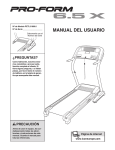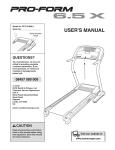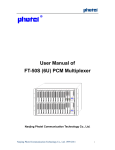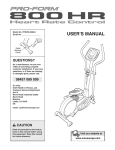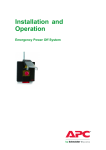Download ProForm 400C Treadmill User Manual
Transcript
Model No. PATL30506.0 Serial No. USER'S MANUAL Serial Number Decal QUESTIONS? If you have questions, or if any parts are missing or damaged, PLEASE CONTACT OUR CUSTOMER SERVICE DEPARTMENT DIRECTLY. Call toll-free: 800-830-7240 E-mail: [email protected] Goodfamily’s Web site: www.goodfamily.cc ICON’s Web site: www.iconfitness.com CAUTION Read all precautions and instructions in this manual before using this equipment. Save this manual for future reference. Goodfamily is an authorized dealer of this treadmill in the territory of mainland China. This treadmill is designed and manufactured by ICON Health & Fitness, Inc. TABLE OF CONTENTS IMPORTANT PRECAUTIONS . . . . . . . . . . . . . . . . . . . . . . . . . . . . . . . . . . . . . . . . . . . . . . . . . . . . . . . . . . . . . . . .3 BEFORE YOU BEGIN . . . . . . . . . . . . . . . . . . . . . . . . . . . . . . . . . . . . . . . . . . . . . . . . . . . . . . . . . . . . . . . . . . . . . .5 ASSEMBLY . . . . . . . . . . . . . . . . . . . . . . . . . . . . . . . . . . . . . . . . . . . . . . . . . . . . . . . . . . . . . . . . . . . . . . . . . . . . . . .6 OPERATION AND ADJUSTMENT . . . . . . . . . . . . . . . . . . . . . . . . . . . . . . . . . . . . . . . . . . . . . . . . . . . . . . . . . . . .13 HOW TO FOLD AND MOVE THE TREADMILL . . . . . . . . . . . . . . . . . . . . . . . . . . . . . . . . . . . . . . . . . . . . . . . . . .18 TROUBLESHOOTING . . . . . . . . . . . . . . . . . . . . . . . . . . . . . . . . . . . . . . . . . . . . . . . . . . . . . . . . . . . . . . . . . . . . .20 CONDITIONING GUIDELINES . . . . . . . . . . . . . . . . . . . . . . . . . . . . . . . . . . . . . . . . . . . . . . . . . . . . . . . . . . . . . . .22 HOW TO ORDER REPLACEMENT PARTS . . . . . . . . . . . . . . . . . . . . . . . . . . . . . . . . . . . . . . . . . . . . .Back Cover Note: An EXPLODED DRAWING and a PART LIST are attached in the center of this manual. PROFORM is a registered trademark of ICON IP, Inc. 2 IMPORTANT PRECAUTIONS WARNING: To reduce the risk of burns, fire, electric shock, or injury to persons, read the following important precautions and information before operating the treadmill. 12. Keep the power cord away from heated surfaces. 1. It is the responsibility of the owner to ensure that all users of this treadmill are adequately informed of all warnings and precautions. 13. Never move the walking belt while the power is turned off. Do not operate the treadmill if the power cord or plug is damaged, or if the treadmill is not working properly. (See TROUBLESHOOTING on page 20 if the treadmill is not working properly.) 2. Use the treadmill only as described. 3. Place the treadmill on a level surface, with at least 2.5 m (8 ft.) of clearance behind it and 0.5 m (2 ft.) on each side. Do not place the treadmill on any surface that blocks air openings. To protect the floor or carpet from damage, place a mat under the treadmill. 14. Read, understand, and test the emergency stop procedure before using the treadmill (see HOW TO TURN ON THE POWER on page 14). 4. Keep the treadmill indoors, away from moisture and dust. Do not put the treadmill in a garage or covered patio, or near water. 15. Never start the treadmill while you are standing on the walking belt. Always hold the handrails while using the treadmill. 5. Do not operate the treadmill where aerosol products are used or where oxygen is being administered. 16. The treadmill is capable of high speeds. Adjust the speed in small increments to avoid sudden jumps in speed. 6. Keep children under the age of 12 and pets away from the treadmill at all times. 17. The pulse sensor is not a medical device. Various factors, including your movement, may affect the accuracy of heart rate readings. The pulse sensor is intended only as an exercise aid in determining heart rate trends in general. 7. The treadmill should be used only by persons weighing 115 kg (250 lbs.) or less. 8. Never allow more than one person on the treadmill at a time. 18. Never leave the treadmill unattended while it is running. Always remove the key and unplug the power cord when the treadmill is not in use. 9. Wear appropriate exercise clothes when using the treadmill. Do not wear loose clothes that could become caught in the treadmill. Athletic support clothes are recommended for both men and women. Always wear athletic shoes; never use the treadmill with bare feet, wearing only stockings, or in sandals. 19. Do not attempt to raise, lower, or move the treadmill until it is properly assembled. (See ASSEMBLY on page 6, and HOW TO FOLD AND MOVE THE TREADMILL on page 18.) You must be able to safely lift 20 kg (45 lbs.) to raise, lower, or move the treadmill. 10. When connecting the power cord (see page 13), plug the power cord into an earthed circuit. No other appliance should be on the same circuit. When replacing the fuse, an ASTA approved BS1362 type should be fitted to the fuse carrier. A 13 amp fuse should be used. 20. When folding or moving the treadmill, make sure that the storage latch is fully closed. 21. Inspect and properly tighten all parts of the treadmill regularly. 11. If an extension cord is needed, use only a 3conductor, 1mm2 (14-gauge) cord that is no longer than 1.5 m (5 ft.). 22. Never insert any object into any opening. 3 23. DANGER: Always unplug the power cord immediately after use, before cleaning the treadmill, and before performing the maintenance and adjustment procedures described in this manual. Never remove the motor hood unless instructed to do so by an authorized service representative. Servicing other than the procedures in this manual should be performed by an authorized service representative only. 24. This treadmill is intended for in-home use only. Do not use this treadmill in a commercial, rental, or institutional setting. WARNING: Before beginning this or any exercise program, consult your physician. This is especially important for persons over the age of 35 or persons with pre-existing health problems. Read all instructions before using. ICON assumes no responsibility for personal injury or property damage sustained by or through the use of this product. SAVE THESE INSTRUCTIONS The decals shown at the right have been placed on the treadmill. If a decal is missing, or if it is not legible, call the toll-free telephone number on the front cover of this manual and order a free replacement decal. Apply the decal in the location shown. Note: The decals are not shown at actual size. 4 BEFORE YOU BEGIN Thank you for selecting the new PROFORM® 400 C treadmill. The 400 C treadmill combines advanced technology with innovative design to help you achieve your fitness goals in the convenience of your home. And when you’re not exercising, the 400 C treadmill can be folded up, requiring less than half the floor space of other treadmills. ing this manual, please see the front cover of this manual. To help us assist you, note the product model number and serial number before contacting us (see the front cover of this manual). Before reading further, please familiarize yourself with the parts that are labeled in the drawing below. For your benefit, read this manual carefully before using the treadmill. If you have questions after read- Accessory Tray Console Handrail Key/Clip Storage Latch Upright On/Off Switch Circuit Breaker Walking Belt Foot Rail Cushioned Walking Platform BACK RIGHT SIDE Rear Roller Adjustment Bolts 5 ASSEMBLY Assembly requires two persons. Set the treadmill in a cleared area and remove all packing materials; do not Wheel Spacerof the treadmill walking dispose of the packing materials until assembly is completed. Note: The underside (94)–4 belt is coated with high-performance lubricant. During shipping, a small amount of lubricant may be transferred to the top of the walking belt or the shipping carton. This does not affect treadmill performance. If there is lubricant on top of the walking belt, simply wipe off the lubricant with a soft cloth and a mild, non-abrasive cleaner. Assembly requires the included hex keys mallet , adjustable wrench 3/4” Tek Screw (58)–8 and your own Phillips screwdriver , rubber , and wire cutters .1/2” Screw (119)–1 For help identifying the assembly hardware, see the drawings below. The number in parentheses below each drawing is the key number of the part, from the PART LIST in the center of this manual. The number following the parentheses is the quantity needed for assembly. Note: If a part is not in the parts bag, check to see if it has been pre-assembled. To avoid damaging plastic parts, do not use power tools for assembly. 1/4” Star Washer (8)–2 Handrail Star Washer (11)–4 Upright Star Washer (6)–4 Upright Washer (7)–2 Frame Washer (65)–2 Nut (12)–2 Silver Ground Screw (10)–2 Console Bolt (2)–2 Handrail Bolt (9)–4 3/4” Screw (3)–6 Upright Bolt (4)–4 Frame Bolt (1)–2 6 1. Make sure that the power cord is unplugged. 1 Identify the Right Upright (39), which has a square hole in the location shown. Orient the Right Upright (39) and the Base (37) as shown. Attach the Right Upright to the Base with two Upright Bolts (4) and two Upright Star Washers (6); do not tighten the Upright Bolts yet. 39 37 6 4 Square Hole 2. Orient the Left Upright (38) as shown, and attach it to the Base (37) with two Upright Bolts (4) and two Upright Star Washers (6); do not tighten the Upright Bolts yet. 2 Latch Holes 37 38 6 6 3. Turn the Base (37) over, and set it near the front of the treadmill as shown. 4 3 39 Wire Locate the wire in the Right Upright (39). See the inset drawing. Secure the wire to the connector on the Upright Wire (69). Then, insert the connector on the Upright Wire into the square hole in the Right Upright. 37 69 Wire 69 7 4. Raise the Uprights (38, 39). 4 38 See the left inset drawing. Identify the two Frame Spacers (96). Open the included packet of grease, and apply grease to both sides of both Frame Spacers. Next, identify the outer side of each Frame Spacer. 39 12 Hold a Frame Spacer (96) and a Frame Washer (65) between the Right Upright (39) and the Lift Frame (41), with the outer side of the Frame Spacer facing the Frame Washer and the Right Upright. Attach the Right Upright to the Lift Frame with a Frame Bolt (1), an Upright Washer (7), and a Nut (12); do not tighten the Nut yet. 7 1 65 41 96 96 39 12 Outer Side 7 65 Inner Side 1 96 41 5. Hold the remaining Frame Spacer (96) and Frame Washer (65) between the Left Upright (38) and the Lift Frame (41), with the outer side of the Frame Spacer facing the Frame Washer and the Left Upright. Attach the Left Upright to the Lift Frame with a Frame Bolt (1), an Upright Washer (7), and a Nut (12); do not tighten the Nut yet. 5 38 12 7 1 65 41 96 96 38 12 Outer Side 1 Inner Side 8 7 65 96 41 6. Pull the wire through the Right Upright (39) until the Upright Wire (69) extends from both ends of the Right Upright. Then, disconnect and discard the wire. 6 69 Wire 39 7. Route the Upright Wire (69) through one of the Handrails (40). Attach the Handrail to the Right Upright (39) with two Handrail Bolts (9) and two Handrail Star Washers (11). Do not to pinch the Upright Wire. 7 9 69 11 38 Attach the other Handrail (40) to the Left Upright (38) with two Handrail Bolts (9) and two Handrail Star Washers (11). Firmly tighten the Handrail Bolts. 9 40 11 40 39 9 8. Have a second person raise and hold the treadmill Frame (36). 8 Cylinder 83 Identify the Gas Spring (83). Note that the Gas Spring has a piston end and a cylinder end. See the two small inset drawings. Locate the Spring Clip (90) in the piston end of the Gas Spring. Using your fingernail or the end of a screwdriver, press on the end of the Spring Clip to loosen it, rotate the Spring Clip, and then pull the Spring Clip out of the Gas Spring. Be careful to avoid losing the Spring Clip. Note: Extra Spring Clips are included. 90 Piston 36 Bracket 90 Next, hold the piston end of the Gas Spring (83) near the bracket in the center of the Frame (36). Press the end of the Gas Spring as far as possible onto the ball on the bracket. 90 8a See drawing 8a. Insert the Spring Clip (90) into the two indicated small holes in the piston end of the Gas Spring (83). Then, rotate the Spring Clip until it clips onto the Gas Spring. 36 83 Bracket 90 Holes 9. Pivot the cylinder end of the Gas Spring (83) down to the position shown. Remove the Spring Clip (90) from the end of the Gas Spring. 9 Next, align the cylinder end of the Gas Spring (83) with the bracket in the center of the Base (37). Press the end of the Gas Spring onto the ball on the bracket. Note: It may be necessary to pivot the Frame forward or backward slightly to align the end of the Gas Spring with the ball. See drawing 9a. Insert the Spring Clip (90) into the two indicated small holes in the Gas Spring (83). Then, rotate the Spring Clip until it clips onto the Gas Spring. 83 37 90 Bracket 9a 83 37 With the help of a second person, lower the Frame (not shown) to the floor. 90 Holes 10 Bracket 10. Attach the ground wire on the Console Base (67) to the right Handrail (40) with a Silver Ground Screw (10). 10 67 Ground Wire 10 Connect the wire harness on the Console Base (67) to the Upright Wire (69) as shown in the inset drawing. Important: If the connectors are oriented correctly, they will slide together easily and snap into place. If the connectors are not oriented correctly, the console may be damaged when the power is turned on. Wire Harness 69 40 Insert the connectors and excess wire into the Console Base (67). 69 11. Attach the Console Base (67) to the Handrails (40) with four 3/4” Screws (3); do not tighten the Screws yet. Next, tighten two Console Bolts (2) with 1/4” Star Washers (8) into the Handrails and the Console Base. Then, tighten the four Screws. 11 67 Front View 40 40 8 3 3 2 8 2 12. Lower the Uprights (38, 39) as shown. 12 Side View See the inset drawing. Push the Uprights (38, 39) sideways so that the treadmill Frame (36) is centered between the Uprights. 38, 39 Firmly tighten the Upright Bolts (4) and the Frame Bolt (1) on each side of the treadmill. Do not overtighten the Frame Bolts. 1 4 36 View from Above 38 11 36 39 13. Attach the ground wire on the Upright Wire (69) to the indicated hole in the Base (37) with a Silver Ground Screw (10). 13 Grommet 39 69 Press the indicated grommet into the Right Upright (39). 37 Ground Wire 10 14. Carefully raise the Uprights (38, 39). 14 Attach the Latch Housing (91) to the Left Upright (38) with two 3/4” Screws (3). Remove the knob from the pin. Make sure that the collar and the spring are on the pin. Insert the pin into the Latch Housing (91), and tighten the knob back onto the pin. 91 Knob 38 3 Spring Pin Collar 15. Make sure that all parts are properly tightened before you use the treadmill. Note: Extra hardware may be included. Keep the included hex keys in a secure place; the large hex key is used to adjust the walking belt (see page 21). To protect the floor or carpet, place a mat under the treadmill. 12 OPERATION AND ADJUSTMENT THE PRE-LUBRICATED WALKING BELT Your treadmill features a walking belt coated with high-performance lubricant. IMPORTANT: Never apply silicone spray or other substances to the walking belt or the walking platform. Such substances will deteriorate the walking belt and cause excessive wear. HOW TO PLUG IN THE POWER CORD This product must be earthed. If it should malfunction or break down, earthing provides a path of least resistance for electric current to reduce the risk of electric shock. This product is equipped with a power cord having an equipment-earthing conductor and an earthing plug. Important: If the power cord is damaged, it must be replaced with a manufacturer-recommended power cord. 1 Socket on Treadmill Power Cord See drawing 1. Plug the indicated end of the power cord into the socket on the treadmill. See drawing 2. Plug the power cord into an appropriate outlet that is properly installed and earthed in accordance with all local codes and ordinances. Important: The treadmill is not compatible with GFCI-equipped outlets. DANGER: 2 Outlet Improper connection of the equipment-earthing conductor can result in an increased risk of electric shock. Check with a qualified electrician or serviceman if you are in doubt as to whether the product is properly earthed. Do not modify the plug provided with the product—if it will not fit the outlet, have a proper outlet installed by a qualified electrician. 13 CONSOLE DIAGRAM Note: If there are thin sheets of plastic on the console, remove the plastic. Clip Key FEATURES OF THE CONSOLE HOW TO TURN ON THE POWER The treadmill console offers a selection of features designed to make your workouts more effective. When you select the manual mode of the console, you can change the speed and incline of the treadmill with the touch of a button. As you exercise, the console will display continuous exercise feedback. You can even measure your heart rate using the built-in pulse sensor. Plug in the power cord (see page 13). Next, locate the on/off switch on the treadmill frame near the power cord. Make sure that the on/off switch is in the “on” position. The console also features five preset programs. Each program controls the speed and incline of the treadmill as it guides you through an effective workout. Next, stand on the foot rails of the treadmill. Locate the clip attached to the key (see the drawing above), and slide the clip securely onto the waistband of your clothes. Then, insert the key into the console; after a moment, the display will light. Important: In an emergency situation, the key can be pulled from the console, causing the walking belt to slow to a stop. Test the clip by carefully taking a few steps backward; if the key is not pulled from the console, adjust the position of the clip. To use the manual mode of the console, follow the steps beginning on page 15. To use a preset program, see page 16. On Position Note: To prevent damage to the walking platform, always wear clean shoes while using the treadmill. 14 Note: The first time you use the treadmill, periodically inspect the alignment of the walking belt, and center it if necessary (see page 20). HOW TO USE THE MANUAL MODE 1 Insert the key into the console. 4 See HOW TO TURN ON THE POWER on page 14. 2 To change the incline of the treadmill, press the Incline increase and decrease buttons. Each time a button is pressed, the incline setting will change by 0.5%; if a button is held down, the incline setting will change quickly. Select the manual mode. When the key is inserted, the manual mode will be selected. If a preset program has been selected, press the Program Select button repeatedly until a track appears in the display. 3 Change the incline of the treadmill as desired. 5 Follow your progress with the display. When the manual mode is selected, a track representing 400 meters (1/4 mile) will appear in the upper right corner of the display. As you walk or run on the treadmill, the indicators around the track will appear in succession until the entire track appears. The track will then disappear and the indicators will again begin to appear in succession. Start the walking belt. To start the walking belt, press the Start button, the Speed increase button, or one of the buttons numbered 2 through 16. If the Start button or the Speed increase button is pressed, the walking belt will begin to move at 2 Km/H. As you exercise, change the speed of the walking belt as desired by pressing the Speed increase and decrease buttons. Each time a button is pressed, the speed setting will change by 0.1 Km/H; if a button is held down, the speed setting will change in increments of 0.5 Km/H. The upper left corner of the display will show the elapsed time since you started your workout. The lower left corner of the display will show the distance that you have walked or run during your workout and the incline level of the treadmill. If one of the nine numbered buttons is pressed, the walking belt will gradually increase in speed until it reaches the selected speed setting. Note: The console can display speed and distance in either miles or kilometers (see THE INFORMATION MODE/DEMO MODE on page 17). For simplicity, all instructions in this section refer to kilometers. The lower right corner of the display will show the speed of the walking belt and the approximate number of calories that you have burned during your workout. The lower right corner of the display will also show your heart rate when you use the handgrip pulse sensor. To stop the walking belt, press the Stop button. The time will begin to flash in the display. To restart the walking belt, press the Start button, the Speed increase button, or one of the nine numbered buttons. To reset the display, press the Stop button, remove the key, and then reinsert the key. 15 6 Measure your heart rate if desired. Before using the handgrip pulse sensor, remove the sheets of clear plastic from the metal contacts. In addition, make sure that your hands are clean. HOW TO USE A PRESET PROGRAM 1 See HOW TO TURN ON THE POWER on page 14. Metal Contacts 2 Select a preset program. To select one of the five preset programs, press the Program Select button repeatedly until “P–1,” “P–2,” “P–3,” “P–4,” or “P–5” appears in the display. When a preset program is selected, the maximum incline setting of the program and the maximum speed setting of the program will flash in the display for a few seconds. The display will then show how long the program will last. A profile of the speed settings of the program will scroll across the matrix in the upper right corner of the display. To measure your heart rate, stand on the foot rails and place your hands on the metal contacts—avoid moving your hands. When your pulse is detected, the heart symbol in the display will begin to flash each time your heart beats, one or two dashes will appear, and then your heart rate will be shown. For the most accurate heart rate reading, continue to hold the contacts for about 15 seconds. 7 Insert the key into the console. When you are finished exercising, remove the key. 3 Step onto the foot rails, press the Stop button, and adjust the incline of the treadmill to the lowest setting. The incline must be at the lowest setting when the treadmill is folded to the storage position, or the treadmill will be damaged. Next, remove the key from the console and put it in a secure place. Note: If the display remains lit after the key is removed, the console is in the “demo” mode. See page 17 and turn off the demo mode. Press the Start button or the Speed increase button to start the program. A moment after the button is pressed, the treadmill will automatically adjust to the first speed and incline settings of the program. Hold the handrails and begin walking. Each program is divided into 30 one-minute periods. One speed setting and one incline setting are programmed for each period. Note: The same speed setting and/or incline setting may be programmed for two or more consecutive periods. When you are finished using the treadmill, switch the on/off switch to the “off” position and unplug the power cord. The speed setting for Current Period the first period will be shown in the flashing Current Period column of the matrix in the display. (The incline settings are not shown in the matrix.) The speed settings for the next few periods will be shown in the columns to the right. When only three seconds remain in the first period of the program, both the Current Period column and the column to the right will flash and a series of tones will sound. If the speed and/or incline of the treadmill is about to change, the speed setting and/or the incline setting will flash in the display to alert you. 16 THE INFORMATION MODE/DEMO MODE When the first period is completed, all speed settings will move one column to the left. The speed setting for the second period will then be shown in the flashing Current Period column and the treadmill will automatically adjust to the speed and incline settings for the second period. Note: If all five of the indicators in the Current Period column are lit, the speed settings may move downward so that only the highest indicators appear in the matrix. The console features an information mode that keeps track of treadmill usage information and allows you to select a unit of measurement for the console. To select the information mode, insert the key into the console while holding down the Stop button. Then, release the Stop button. When the information mode is selected, the following information will be shown: The program will continue in this way until the speed setting for the last period is shown in the Current Period column and the last period ends. The walking belt will then slow to a stop. An “E” (for English) or an “M” (for metric) will appear in the lower right corner of the display. Press the Speed increase button to change the unit of measurement, if desired. IMPORTANT: If a “d” appears in the display, the console is in the “demo” mode. This mode is intended to be used only when a treadmill is displayed in a store. When the console is in the demo mode, the power cord can be plugged in, the key can be removed from the console, and the display will remain lit; the buttons will not operate. If a “d” appears when the information mode is selected, press the Speed decrease button so the “d” disappears. If the speed or incline setting for the current period is too high or too low for you, you can manually override the setting by pressing the Speed or Incline buttons. Every few times a Speed button is pressed, an additional indicator will appear or disappear in the Current Period column; if any of the columns to the right of the Current Period column have the same number of lit indicators as the Current Period column, an additional indicator may appear or disappear in those columns as well. Important: When the current period of the program ends, the treadmill will automatically adjust to the speed and incline settings for the next period. The upper left corner of the display will show the total number of hours that the treadmill has been used. To stop the program temporarily, press the Stop button. The time will begin to flash in the display. To restart the program, press the Start button or the Speed increase button. The walking belt will begin to move at 2 Km/H. When the next period of the program begins, the treadmill will automatically adjust to the speed and incline settings for the next period. To end the program, press the Stop button, remove the key, and then reinsert the key. 4 The lower left corner of the display will show the total number of kilometers (or miles) that the walking belt has moved. To exit the information mode, remove the key from the console. Follow your progress with the display. See step 5 on page 15. 5 Measure your heart rate if desired. See step 6 on page 16. 6 When the program is completed, remove the key from the console. See step 7 on page 16. 17 HOW TO FOLD AND MOVE THE TREADMILL HOW TO FOLD THE TREADMILL FOR STORAGE Before folding the treadmill, adjust the incline to the lowest position. If this is not done, the treadmill may be permanently damaged. Next, unplug the power cord. CAUTION: You must be able to safely lift 20 kg (45 lbs.) to raise, lower, or move the treadmill. 1. Hold the metal frame firmly in the location shown by the arrow at the right. CAUTION: To decrease the possibility of injury, do not lift the frame by the plastic foot rails. Make sure to bend your legs and keep your back straight as you raise the frame—do not lift with your back. Raise the frame about halfway to the vertical position. Frame 2. Move your right hand to the position shown and hold the treadmill firmly. Using your left hand, pull the latch knob to the left and hold it. Raise the frame until the hole in the frame is aligned with the latch pin, and then slowly release the latch knob. Make sure that the latch pin is fully inserted into the frame. To protect the floor or carpet from damage, place a mat under the treadmill. Keep the treadmill out of direct sunlight. Do not leave the treadmill in the storage position in temperatures above 30° C (85° F). Latch Knob Latch Pin HOW TO MOVE THE TREADMILL Deck Before moving the treadmill, convert the treadmill to the storage position as described above. Make sure that the latch pin is fully inserted into the storage latch. 1. Hold one handrail and place your other hand on the deck. Place a foot against one of the wheels. Handrail 2. Tilt the treadmill back until it rolls freely on the wheels. Carefully move the treadmill to the desired location. To reduce the risk of injury, use extreme caution while moving the treadmill. Do not move the treadmill over an uneven surface. 3. Place a foot against one of the wheels, and carefully lower the treadmill until it is resting in the storage position. 18 Wheel Engaged HOW TO LOWER THE TREADMILL FOR USE 1. Hold the treadmill with your right hand as shown. Pull the latch knob to the left and hold it. Pivot the frame down until it is past the latch pin. Latch Knob Latch Pin 2. Hold the metal frame firmly with both hands, and lower it to the floor. CAUTION: To decrease the possibility of injury, do not lower the frame by gripping only the plastic foot rails. Do not drop the frame to the floor. Make sure to bend your legs and keep your back straight. Frame 19 TROUBLESHOOTING Most treadmill problems can be solved by following the steps listed below. Find the symptom that applies, and follow the steps listed. If you need further assistance, please see the front cover of this manual. PROBLEM: The power does not turn on SOLUTION: a. Make sure that the power cord is plugged into a properly earthed outlet (see page 13). If an extension cord is needed, use only a 3-conductor, 1 mm2 (14-gauge) cord that is no longer than 1.5 m (5 ft.). Important: The treadmill is not compatible with GFCI-equipped outlets. b. After the power cord has been plugged in, make sure that the key is inserted into the console. c. Check the circuit breaker located on the treadmill near the power cord. If the switch protrudes as shown, the circuit breaker has tripped. To reset the circuit breaker, wait for five minutes and then press the switch back in. d. Check the on/off switch located on the treadmill near the power cord. The switch must be in the “on” position. c Tripped Reset d On Position PROBLEM: The power turns off during use SOLUTION: a. Check the circuit breaker located on the treadmill frame near the power cord (see the drawing above). If the circuit breaker has tripped, wait for five minutes and then press the switch back in. b. Make sure that the power cord is plugged in. If the power cord is plugged in, unplug it, wait for five minutes, and then plug it back in. c. Remove the key from the console. Reinsert the key into the console. d. Make sure that the on/off switch is in the “on” position (see d. above). e. If the treadmill still will not run, see the front cover of this manual. PROBLEM: The displays of the console do not function properly SOLUTION: a. Remove the key from the console and UNPLUG THE POWER CORD. Remove the two Foot Rail Screws (26) and the two Screws (3), and carefully remove the Hood (56). a 3 26 26 56 20 Locate the Reed Switch (59) and the Magnet (98) on the left side of the Pulley (86). Turn the Pulley until the Magnet is aligned with the Reed Switch. Make sure that the gap between the Magnet and the Reed Switch is about 3 mm (1/8 in.). If necessary, loosen the Screw (10), move the Reed Switch slightly, and then retighten the Screw. Reattach the Hood (not shown), and run the treadmill for a few minutes to check for a correct speed reading. 3 mm 10 86 59 98 Top View PROBLEM: The walking belt slows when walked on SOLUTION: a. If an extension cord is needed, use only a 3-conductor, 1mm2 (14-gauge) cord that is no longer than 1.5 m (5 ft.). b. If the walking belt is overtightened, treadmill performance may decrease and the walking belt may become damaged. Remove the key and UNPLUG THE POWER CORD. Using the hex key, turn both rear roller bolts counterclockwise 1/4 of a turn. When the walking belt is properly tightened, you should be able to lift each edge of the walking belt 5 to 7 cm (2 to 3 in.) off the walking platform. Be careful to keep the walking belt centered. Then, plug in the power cord, insert the key, and run the treadmill for a few minutes. Repeat until the walking belt is properly tightened. b 5–7cm Rear Roller Bolts c. If the walking belt still slows when walked on, see the front cover of this manual. PROBLEM: The walking belt is off-center or slips when walked on SOLUTION: a. If the walking belt is off-center, first remove the key and UNPLUG THE POWER CORD. If the walking belt has shifted to the left, use the hex key to turn the left rear roller bolt clockwise 1/2 of a turn; if the walking belt has shifted to the right, turn the left bolt counterclockwise 1/2 of a turn. Be careful not to overtighten the walking belt. Then, plug in the power cord, insert the key, and run the treadmill for a few minutes. Repeat until the walking belt is centered. b. If the walking belt slips when walked on, first remove the key and UNPLUG THE POWER CORD. Using the hex key, turn both rear roller bolts clockwise, 1/4 of a turn. When the walking belt is correctly tightened, you should be able to lift each edge of the walking belt 5 to 7 cm (2 to 3 in.) off the walking platform. Be careful to keep the walking belt centered. Then, plug in the power cord, insert the key, and carefully walk on the treadmill for a few minutes. Repeat until the walking belt is properly tightened. 21 a b CONDITIONING GUIDELINES WARNING: Before beginning this or any exercise program, consult your physician. This is especially important for individuals over the age of 35 or individuals with preexisting health problems. The pulse sensor is not a medical device. Various factors, including your movement, may affect the accuracy of heart rate readings. The sensor is intended only as an exercise aid in determining heart rate trends in general. The following guidelines will help you to plan your exercise program. For more detailed exercise information, obtain a reputable book or consult your physician. EXERCISE INTENSITY Whether your goal is to burn fat or to strengthen your cardiovascular system, the key to achieving the desired results is to exercise with the proper intensity. The proper intensity level can be found by using your heart rate as a guide. The chart below shows recommended heart rates for fat burning and aerobic exercise. To find the proper heart rate for you, first find your age near the bottom of the chart (ages are rounded off to the nearest ten years). Next, find the three numbers above your age. These three numbers define your “training zone.” The lower two numbers are recommended heart rates for fat burning; the higher number is the recommended heart rate for aerobic exercise. Fat Burning To burn fat effectively, you must exercise at a relatively low intensity level for a sustained period of time. During the first few minutes of exercise, your body uses easily accessible carbohydrate calories for energy. Only after the first few minutes does your body begin to use stored fat calories for energy. If your goal is to burn fat, adjust the speed and incline of the treadmill until your heart rate is near the lowest number in your training zone. For maximum fat burning, adjust the speed and incline of the treadmill until your heart rate is near the middle number in your training zone. Aerobic Exercise If your goal is to strengthen your cardiovascular system, your exercise must be “aerobic.” Aerobic exercise is activity that requires large amounts of oxygen for prolonged periods of time. This increases the demand on the heart to pump blood to the muscles, and on the lungs to oxygenate the blood. For aerobic exercise, adjust the speed and incline of the treadmill until your heart rate is near the highest number in your training zone. WORKOUT GUIDELINES Each workout should include the following three parts: A Warm-up—Start each workout with 5 to 10 minutes of stretching and light exercise. A proper warm-up increases your body temperature, heart rate, and circulation in preparation for exercise. Training Zone Exercise—After warming up, increase the intensity of your exercise until your pulse is in your training zone for 20 to 60 minutes. (During the first few weeks of your exercise program, do not keep your pulse in your training zone for longer than 20 minutes.) Breathe regularly and deeply as you exercise—never hold your breath. A Cool-down—Finish each workout with 5 to 10 minutes of stretching to cool down. This will increase the flexibility of your muscles and will help prevent postexercise problems. EXERCISE FREQUENCY To maintain or improve your condition, complete three workouts each week, with at least one day of rest between workouts. After a few months, you may complete up to five workouts each week if desired. The key to success is to make exercise a regular and enjoyable part of your everyday life. 22 SUGGESTED STRETCHES The correct form for several basic stretches is shown at the right. Move slowly as you stretch—never bounce. 1. Toe Touch Stretch Stand with your knees bent slightly and slowly bend forward from your hips. Allow your back and shoulders to relax as you reach down toward your toes as far as possible. Hold for 15 counts, then relax. Repeat 3 times. Stretches: Hamstrings, back of knees, and back. 1 2. Hamstring Stretch Sit with one leg extended. Bring the sole of the opposite foot toward you and rest it against the inner thigh of your extended leg. Reach toward your toes as far as possible. Hold for 15 counts, then relax. Repeat 3 times for each leg. Stretches: Hamstrings, lower back, and groin. 2 3. Calf/Achilles Stretch With one leg in front of the other, reach forward and place your hands against a wall. Keep your back leg straight and your back foot flat on the floor. Bend your front leg, lean forward and move your hips toward the wall. Hold for 15 counts, then relax. Repeat 3 times for each leg. To further stretch the achilles tendons, bend your back leg as well. Stretches: Calves, achilles tendons, and ankles. 3 4 4. Quadriceps Stretch With one hand against a wall for balance, reach back and grasp one foot with your other hand. Bring your heel as close to your buttocks as possible. Hold for 15 counts, then relax. Repeat 3 times for each leg. Stretches: Quadriceps and hip muscles. 5. Inner Thigh Stretch Sit with the soles of your feet together and your knees outward. Pull your feet toward your groin area as far as possible. Hold for 15 counts, then relax. Repeat 3 times. Stretches: Quadriceps and hip muscles. 23 5 PART LIST—Model No. PATL30506.0 Key No. Qty. 1 2 3 4 5 6 7 8 9 10 11 12 13 14 15 16 17 18 19 20 21 22 23 24 25 26 27 28 29 30 31 32 33 34 35 36 37 38 39 40 41 42 43 44 45 46 47 48 49 50 51 52 53 54 55 2 2 22 4 2 5 2 2 4 14 4 7 1 1 1 2 4 2 2 2 2 13 2 1 1 8 1 4 2 2 2 4 1 4 4 1 1 1 1 2 1 1 2 1 1 1 2 2 1 2 4 2 4 1 1 Description Frame Bolt Console Bolt 3/4” Screw Upright Bolt Wheel Bolt Upright Star Washer Upright Washer 1/4” Star Washer Handrail Bolt Silver Ground Screw Handrail Star Washer Nut 5/32” Hex Key Hex Key Motor Pivot Bolt Motor Bolt Belt Guide Screw Motor Tension Bolt Rear Roller Bolt Platform Bolt, Front Platform Bolt, Rear 3/4” Tek Screw Lift Frame Bolt Incline Motor Bolt, Top Incline Motor Bolt, Bottom Foot Rail Screw Ground Bolt Power Bracket Star Washer Flat Washer 3/8” Flange Nut 3/8” Nut Platform Nut Ground Nut U-nut Isolator Fastener Frame Base Left Upright Right Upright Handrail Lift Frame Electronics Bracket Rear Roller Bracket Motor Bracket Console Support Bracket Stop Bracket Belt Guide Isolator Belly Pan Frame Pivot Spacer Base Pad Base Endcap Handrail Endcap Left Foot Rail Right Foot Rail Key No. Qty. 56 57 58 59 60 61 62 63 64 65 66 67 68 69 70 71 72 73 74 75 76 77 78 79 80 81 82 83 84 85 86 87 88 89 90 91 92 93 94 95 96 97 98 # # # # # # # # # 1 1 1 1 1 1 2 1 1 2 1 1 1 1 1 1 1 1 1 2 9 1 1 1 1 1 1 1 1 1 1 1 1 2 2 1 1 1 4 2 2 1 1 1 1 1 1 1 1 1 1 1 R1106A Description Hood Left Rear Foot Right Rear Foot Reed Switch Lift Motor Drive Motor Plastic Motor Bushing Plastic Motor Plate Controller Frame Washer Transformer Console Base Console Upright Wire 8” Wire, F/R 10” Wire Harness 4” Green Wire, F/R Power Cord 10” Wire Plastic Tie Wire Tie 8” Releasable Tie Clip Releasable Tie Power Inlet Bracket Walking Platform Walking Belt Gas Spring Front Roller/ Pulley Motor Belt Rear Roller Warning Decal ProSoft Decal Caution Decal Gas Spring Clip Kit Latch Housing Key/Clip Latch Pin Assembly Wheel Spacer Wheel Frame Spacer Plug Adapter Magnet 14” Blue Wire, 2F 14” Blue Wire, M/F 8” White Wire, 2F 16” White Wire, 2F 6” Blue Wire, 2F 8” Black Wire, M/F 4” Black Wire, 2Ring 10” Red Wire, M/F User’s Manual #These parts are not illustrated Specifications are subject to change without notice. 19 43 8 22 13 26 14 22 57 32 21 87 26 56 19 58 8 88 86 22 48 26 3 22 43 32 21 35 82 20 32 26 17 47 54 26 36 81 26 84 75 78 29 50 59 88 12 44 23 85 48 15 98 10 63 18 35 3 26 20 10 7 61 6 17 22 31 30 18 16 12 47 29 41 62 50 32 55 24 12 25 28 80 22 26 12 70 22 10 31 72 33 7 12 60 46 10 28 97 23 94 22 64 49 79 94 95 5 27 53 71 73 10 66 74 93 40 10 42 89 28 6 4 91 10 12 51 77 3 11 9 1 38 8 83 90 7 34 53 37 2 3 94 95 12 96 65 53 92 68 67 40 52 94 10 3 69 5 69 45 51 22 11 9 3 3 51 22 89 96 8 3 53 3 65 76 39 34 2 3 3 3 7 1 4 6 3 51 22 52 3 10 3 EXPLODED DRAWING—Model No. PATL30506.0 R1106A ORDERING REPLACEMENT PARTS To order replacement parts, call our Customer Service Department toll-free at 800-830-7240, or call: Beijing: 010-60291675 Guizhou: 0851-5617855 Shanghai: 021-28323250 Changchun: 0431-6824991 Ha’erbin: 0451-82712011 Shenyang: 024-31307941 Changsha: 0731-4825618 Hangzhou: 0571-85042441 Shenzhen: 0755-83248325 Changzhou: 0519-8814375 Hefei: 0551-2885888 Shijiazhuang: 0311-86215146 Chengdu: Jinan: 0531-86292209 Suzhou: 0512-67778033 Chongqing: 023-65457730 Kunming: 0871-3130512 Wuhan: 027-87275455 Dalian: Lanzhou: 0931-8832466 Xi’an: 029-87891305 Dongguan: 0755-83248325 Nanjing: 025-85640306 Xinjiang: 0991-8825951 Fuzhou: Nanning: 0711-5328287 Yantai: 0635-6247101 Nantong: 0513-85292002 Yinchuan: 0951-6719831 028-86927825 0411-86668012 0591-87734032 Guangzhou: 020-37652999 When ordering parts, please be prepared to provide the following information: • • • • the MODEL NUMBER of the product (PATL30506.0) the NAME of the product (PROFORM 400 C treadmill) the SERIAL NUMBER of the product (see the front cover of this manual) the KEY NUMBER and DESCRIPTION of the part(s) (see the PART LIST and EXPLODED DRAWING attached in the center of this manual) LIMITED WARRANTY Goodfamily, Inc. (Goodfamily), warrants this product to be free from defects in workmanship and material, under normal use and service conditions, for a period of ninety (90) days from the date of purchase. This warranty extends only to the original purchaser. Goodfamily's obligation under this warranty is limited to replacing or repairing, at Goodfamily's option, the product through one of its authorized service centers. All repairs for which warranty claims are made must be pre-authorized by Goodfamily. This warranty does not extend to any product or damage to a product caused by or attributable to freight damage, abuse, misuse, improper or abnormal usage or repairs not provided by a Goodfamily authorized service center; products used for commercial or rental purposes; or products used as store display models. No other warranty beyond that specifically set forth above is authorized by Goodfamily. Goodfamily is not responsible or liable for indirect, special or consequential damages arising out of or in connection with the use or performance of the product or damages with respect to any economic loss, loss of property, loss of revenues or profits, loss of enjoyment or use, costs of removal or installation or other consequential damages of whatsoever nature. Some states do not allow the exclusion or limitation of incidental or consequential damages. Accordingly, the above limitation may not apply to you. The warranty extended hereunder is in lieu of any and all other warranties and any implied warranties of merchantability or fitness for a particular purpose is limited in its scope and duration to the terms set forth herein. Some states do not allow limitations on how long an implied warranty lasts. Accordingly, the above limitation may not apply to you. This warranty gives you specific legal rights. You may also have other rights which vary from state to state. Goodfamily, Inc. Part No. 243093 R1106A Printed in China © 2006 ICON IP, Inc.


























